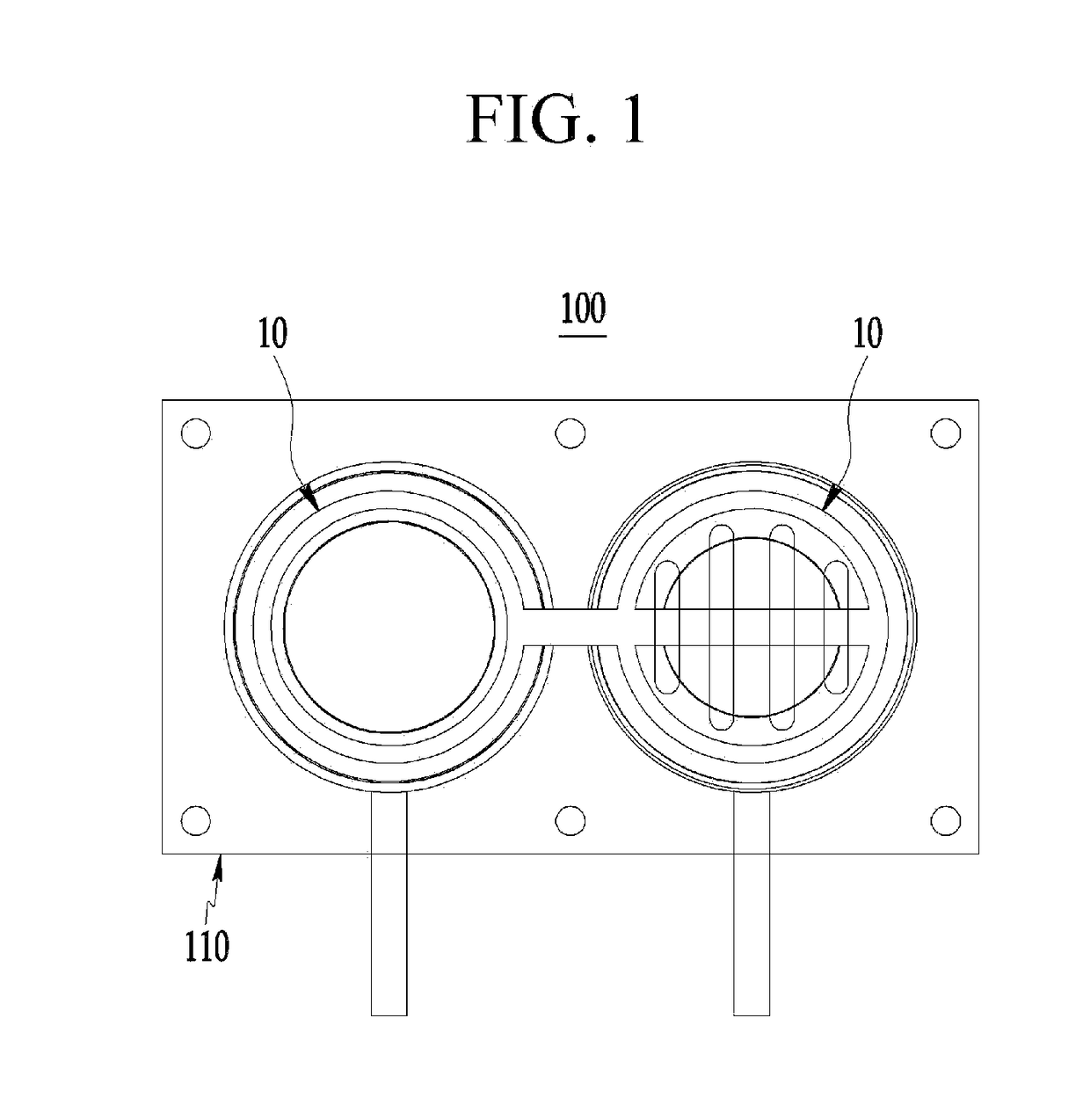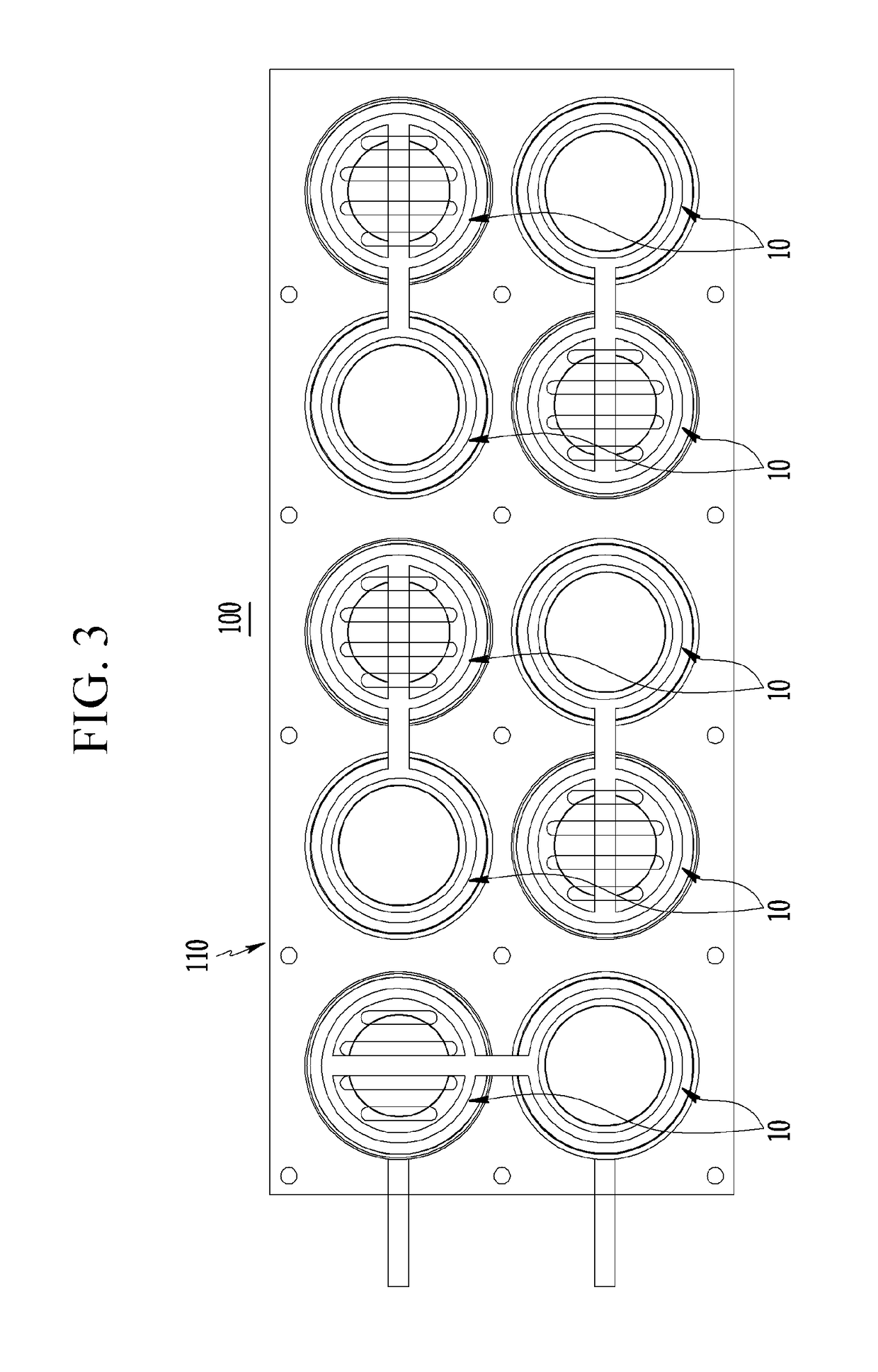Rechargeable battery module and method for manufacturing the same
a rechargeable battery and module technology, applied in the field of rechargeable battery modules, can solve the problems of limited amount of lithium in the earth, high energy consumption, and general extraction of lithium, and achieve the effects of reducing the related costs and environmental problems, widening the application field, and reducing manufacturing costs
- Summary
- Abstract
- Description
- Claims
- Application Information
AI Technical Summary
Benefits of technology
Problems solved by technology
Method used
Image
Examples
first exemplary embodiment
[0069]FIG. 1 illustrates a rechargeable battery module according to a first exemplary embodiment of the present invention.
[0070]FIG. 1 to FIG. 3 respectively illustrate a rechargeable battery module 100 in which a plurality of coin batteries 10 are connected in series, and specifically, FIG. 1 illustrates a structure in which two coin batteries 10 are connected in series, FIG. 2 illustrates a structure in which five coin batteries 10 are connected in series, and FIG. 3 illustrates a structure in which ten coin batteries 10 are connected in series.
[0071]Since the rechargeable battery modules 100 in illustrated in FIG. 1 to FIG. 3 have the same configuration except for the number of coin batteries 10 and the number of parts according the number of coin batteries 10, the first exemplary embodiment will be described with reference to the rechargeable battery module 100 of FIG. 1 in which the two coin batteries 10 are connected in series.
[0072]FIG. 4 illustrates a configuration of the re...
second exemplary embodiment
[0137]FIG. 6 and FIG. 7 respectively illustrate a rechargeable battery module according to a second exemplary embodiment of the present invention, that is, a large-capacity rechargeable battery module in which a plurality of coin batteries are connected in parallel.
[0138]A structure of a rechargeable battery module 200 of the present exemplary embodiment is the same as that of the rechargeable battery module of the first exemplary embodiment described above except that the plurality of coin batteries 10 are connected in parallel. Thus, like reference numerals designate like or similar constituent elements, and a detailed description thereof will be omitted.
[0139]In the rechargeable battery module having a parallel connection structure, the number of the coin batteries 10 may be variously changed.
[0140]The rechargeable battery module 200 of the present exemplary embodiment includes the plurality of coin batteries 10 and the battery pack 110 that supports the plurality of coin batteri...
third exemplary embodiment
[0150]FIG. 8 and FIG. 9 respectively illustrate a rechargeable battery module according to a third exemplary embodiment of the present invention.
[0151]As shown in FIG. 8 and FIG. 9, a rechargeable battery module 300 of the present exemplary embodiment includes a plurality of unit cells 11 and the battery pack 110 that supports the plurality of unit cells 11 and electrically connects them.
[0152]Thus, the plurality of unit cells 11 are connected in parallel in one battery pack 110 to form a large-capacity rechargeable battery module 300.
[0153]As described above, the unit cell 11, as a minimum unit of a rechargeable battery, includes the negative electrode 13, the positive electrode 12, and the solid electrolyte 14 positioned between the negative electrode 13 and the positive electrode 12.
[0154]The unit cell 11 and the battery pack 110 are assembled to substantially form the rechargeable battery, and according to the present exemplary embodiment, the plurality of unit cells 11 are moun...
PUM
| Property | Measurement | Unit |
|---|---|---|
| lattice structure | aaaaa | aaaaa |
| circumference | aaaaa | aaaaa |
| outer diameter | aaaaa | aaaaa |
Abstract
Description
Claims
Application Information
 Login to View More
Login to View More - R&D
- Intellectual Property
- Life Sciences
- Materials
- Tech Scout
- Unparalleled Data Quality
- Higher Quality Content
- 60% Fewer Hallucinations
Browse by: Latest US Patents, China's latest patents, Technical Efficacy Thesaurus, Application Domain, Technology Topic, Popular Technical Reports.
© 2025 PatSnap. All rights reserved.Legal|Privacy policy|Modern Slavery Act Transparency Statement|Sitemap|About US| Contact US: help@patsnap.com



